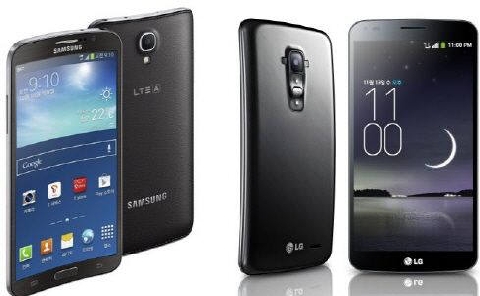To recover from the failure of smartphones that adopted flexible AMOLED last year, LG Display and Samsung Display are trying different things. LG Display’s core strategy is ‘performance’ while that of Samsung Display is reinforcement of the ‘form factor.’
According to industry insiders on March 30, LG Display will focus on reducing the size of flexible AMOLED and improving performance, e.g. enhancing the resolution. On the other hand, Samsung Display is planning to develop various forms of flexible AMOLED and make design the game changer.
The strategies of these two companies run counter to their strategies of last year when they released the curved smartphones with the flexible AMOLED. LG Electronics applied the 6-inch HD Plastic OLED display to the G Flex. As the G Flex is larger than the Samsung Galaxy Round (5.68-inch, full HD), but has a lower resolution, it has been pointed out that it is inferior in terms of performance. On the other hand, Samsung Electronics emphasized the horizontal curvature unlike LG, but it was actually a ‘curved display,’ not a ‘bendable display.’ Unlike the parts of the G Flex, those of the Galaxy Round, such as the battery and frame, were not flexible.
The two companies have different strategies this year. LG Display is planning to reduce the size to 55 inches this year, but increase the resolution to the full HD. Also, LG Display is concentrating on resolving such problems as the temporary residual image due to heat.
An LG Display insider said, “Our goal is to enhance product performance a notch or higher across the board.”
On the other hand, Samsung Display decided to develop a product with various types of curvature (vertical, horizontal and edge curvature) this year jointly with Samsung Electronics and apply them to smartphones. Samsung believes that it will be the design that will determine the success or failure of the flexible AMOLED.
Samsung Electronics and LG Electronics will unveil smartphones with the flexible AMOLED sometime this year. It is unknown whether they will retain the product names of their predecessors.
“The low yield, high price and development of related parts are still issues that remain unresolved,” said Kang Min-soo, a researcher of a market survey firm IHS. “For the time being, flexible displays will not be found on smartphones very often.”
In the meantime, Samsung Electronics and LG Electronics have sold fewer than 100,000 curved smartphones until now. This figure is far less than their panel supply capacity. According to IHS, LG Display and Samsung Display’s flexible AMOLED production capacity was 12,000 sheets for the 3.5G line and 8,000 sheets for the 5.5G line per month last year.
Sung Hyeon-hee | sunghh@etnews.com
플렉시블 AM OLED 시장 놓고 LG는 ‘성능’, 삼성은 ‘폼팩터’ 전면에
<삼성전자(왼쪽)와 LG전자의 커버드 스마트폰.>
LG디스플레이와 삼성디스플레이가 지난해 플렉시블 능동형(AM) 유기발광다이오드(OLED)를 채택한 스마트폰의 실패를 만회하기 위해 각기 다른 카드를 꺼내 들었다. LG디스플레이는 ‘성능’을 삼성디스플레이는 ‘폼 팩터’ 강화를 후속작의 핵심 전략으로 삼았다.
30일 업계에 따르면 LG디스플레이는 올해 플렉시블 AM OLED의 크기를 줄이고, 해상도를 높이는 등 성능 개선에 주력한다. 반면에 삼성디스플레이는 다양한 형태의 플렉시블 AM OLED를 개발해 디자인에서 승부를 띄운다는 계획이다.
양사의 전략은 지난해 플렉시블 AM OLED를 채택한 커브드 스마트폰 출시 당시와 상반된다. LG전자는 G플렉스에 6인치 HD 플라스틱 OLED 디스플레이를 적용했다. 삼성 갤럭시 라운드(5.68인치, 풀HD)보다 크기는 컸지만 해상도가 낮아 성능에서 한 단계 뒤진다는 지적을 받았다. 반면에 삼성전자는 LG와 달리 가로로 휘는 특징을 내세웠지만 사실상 ‘휘는 디스플레이’라기 보다 ‘휘어진 채 나온 디스플레이’로 평가받았다. G플렉스와 달리 배터리와 프레임 등 부품을 플렉시블 제품으로 탑재하지 않았다.
양사는 올 들어 엇갈린 전략을 펼치고 있다. LG디스플레이는 올해 크기를 5.5인치대로 줄이면서도 해상도를 풀HD로 높일 계획이다. 또 발열에 의한 일시적인 잔상 등의 문제를 해결하는 데 주력하고 있다.
LG디스플레이 관계자는 “전체적으로 제품 성능을 한 단계 이상 높이는 것을 목표로 개발하고 있다”고 말했다.
반면에 삼성디스플레이는 올해 삼성전자와 함께 수직?수평?측면(에지 커브드) 등 다양한 형태로 휘어지는 제품을 개발해 스마트폰에 적용하기로 했다. 삼성은 플렉시블 AM OLED가 결국 디자인에서 성패가 갈린다고 판단한다.
삼성전자와 LG전자는 연내 플렉시블 AM OLED를 탑재한 스마트폰을 내놓을 예정이다. 전작의 제품명을 그대로 유지할지는 아직 미지수다.
시장조사 업체 IHS 강민수 연구원은 “낮은 수율, 높은 가격, 관련 부품 개발 등은 여전히 해결해야 할 숙제”라며 “당분간은 스마트폰에서 플렉시블 디스플레이 활용도는 높지 않을 것”으로 전망했다.
한편 지금까지 삼성전자와 LG전자의 커브드 스마트폰 판매 실적은 10만대 미만이다. 이는 패널 공급 능력에 크게 못 미치는 수준이다. IHS에 따르면 LG디스플레이와 삼성디스플레이의 플렉시블 AM OLED 생산능력은 지난해 각각 3.5세대 라인 기준 월 1만2000장, 5.5세대 라인 기준 8000장 규모였다.
성현희기자 | sunghh@etnews.com
